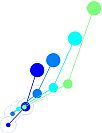Many of our decisions are taken in a social context. The sole presence of a peer engaged in a similar task, as opposed to being alone (i.e., private context), has been shown to impact how we make decisions and perceive outcomes (Bault et al., 2009; 2011). These outcomes could be processed in multiple ways. In addition to the obtained outcome, we also evaluate the outcome of the alternative unchosen option (private counterfactual outcome) and, in a social context, the outcome obtained by a peer (social counterfactual outcome). While previous neuroimaging studies suggest that the rostromedial prefrontal cortex (rmPFC) and the precuneus both encode social counterfactual signals (Bault et al., 2011), their specific contribution and causal role into integrating those signals into the decision-making process remains to be established. In a double-blind sham-controlled study, an 80s 5Hz theta patterned transcranial ultrasound stimulation (TUS) was applied either to the rmPFC (N=40) or the precuneus (N=40) in two different groups of participants. We used a probabilistic gambling task (Bault et al., 2011, 2019) coupled with fMRI to assess the offline effect of TUS on the behavioural and neural activity related to choices and counterfactual signals. In half of the trials, participants performed the task alone (private context), and in the other half, participants could observe the choices and outcomes of a peer (social context). We first replicated previous findings on the effect of the private versus social context on behaviour. However, contrary to our prediction, stimulation of the rmPFC induced behavioural changes mainly in the private context, while stimulation of the precuneus induced effects in both the private and social contexts. These changes were observed mainly on how participants use counterfactual outcomes to guide their decision. Participants relied differently on the anticipated differences between outcomes of the chosen and counterfactual choices (i.e., regret) depending on the stimulation sites. Whereas regret aversion increased following the stimulation of the rmPFC, it decreased after stimulating the precuneus in the private context. Stimulation of the precuneus but not the rmPFC impacted on anticipated regret in the social context. Ongoing analyses are investigating the effect of TUS on neural activity.
Recherche par auteur > Bault NadègeTUS of rmPFC and precuneus differentially modulate decision making in private and social contexts
1 : Brain Research and Imaging Centre (BRIC), University of Plymouth, Plymouth
2 : School of Psychology, University of Plymouth, Plymouth
3 : Institut cellule souche et cerveau / Stem Cell and Brain Research Institute
Université Claude Bernard Lyon 1, Université de Lyon, Institut National de la Santé et de la Recherche Médicale : U1208
4 : Wellcome Centre for Integrative Neuroimaging (WIN), Department of Experimental Psychology, Tinsley Building, Mansfield Road, Oxford OX1 3TA, University of Oxford, Oxford, UK
5 : University Hospitals Plymouth NHS Trust, Plymouth
|

 PDF version
PDF version
